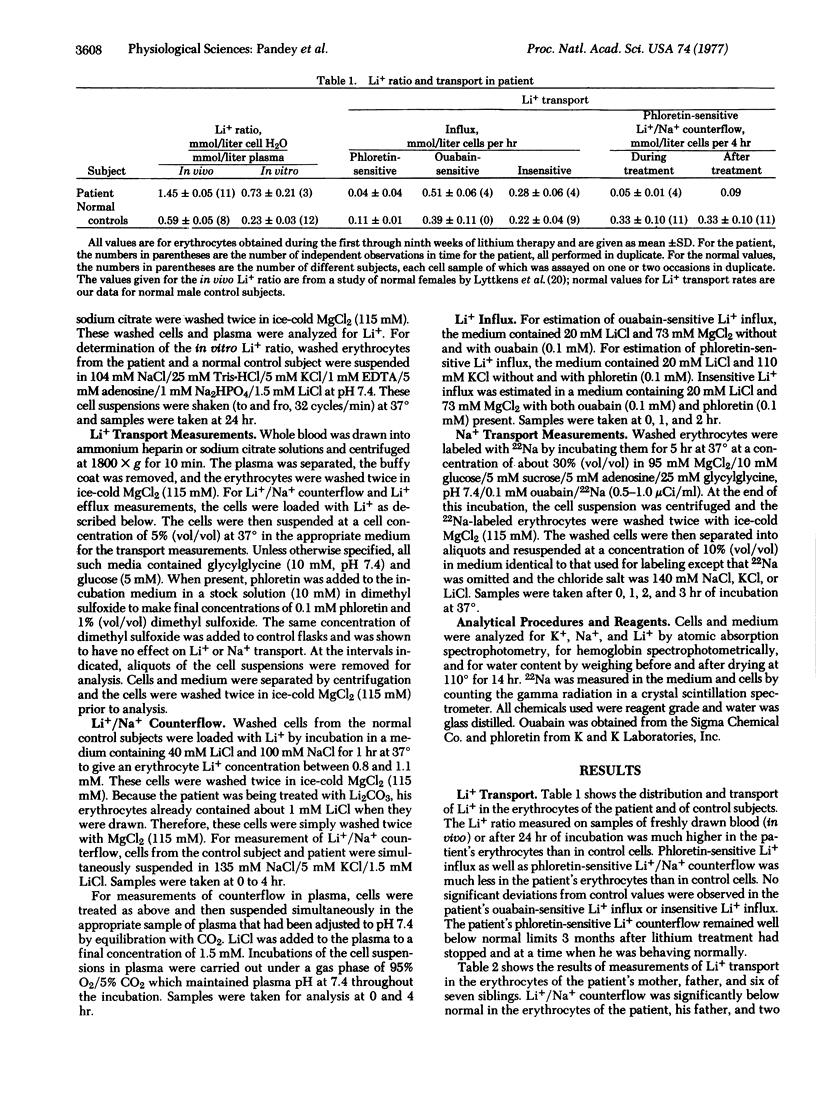Abstract
This paper compares the transport of Li+ and Na+ in erythrocytes from a patient with mania and from members of his family to that in erythrocytes from normal humans. In normal human erythrocytes, Li+ is transported by at least three operationally distinct pathways: one inhibited by ouabain (ouabain-sensitive), one by phloretin (phloretin-sensitive), and one not inhibited by either compound (insensitive). Li+ can be driven up its electrochemical potential gradient by an oppositely directed electrochemical potential gradient for Na+—i.e., Li+/Na+ counterflow can occur—through the phloretin-sensitive pathway but not through the other two pathways. Because ouabain-sensitive Li+ transport is negligible under physiological conditions, Li+ distribution between erythrocytes and plasma in vivo depends mainly on the balance between Li+/Na+ counterflow and the insensitive pathway(s) of Li+ transport. The steady-state ratio of Li+ concentration in the erythrocytes to that in the plasma of the patient was between 2 and 3 times higher than the comparable ratio in normal persons. The phloretin-sensitive Li+/Na+ counterflow system was almost absent in the erythrocytes of the patient. Furthermore, unlike those from normal individuals, the patient's erythrocytes showed no external Li+-stimulated, phloretin-sensitive, ouabain-insensitive Na+ efflux. The magnitudes of the ouabain-sensitive and insensitive pathways for Li+ transport in the patient's erythrocytes were within normal limits. The decreased Li+/Na+ counterflow in the patient's erythrocytes was probably not due to the presence of an inhibitor in the plasma of the patient but rather to an intrinsic defect in the erythrocytes. Because the father and several siblings of the patient showed a similar abnormality in erythrocyte Li+/Na+ transport, it is probable that this defect is inherited.
Keywords: erythrocyte membranes, Li+-Na+ counterflow, phloretin, ouabain
Full text
PDF




Selected References
These references are in PubMed. This may not be the complete list of references from this article.
- Casper R. C., Pandey G., Gosenfeld L., Davis J. M. Intracellular lithium and clinical response. Lancet. 1976 Aug 21;2(7982):418–419. doi: 10.1016/s0140-6736(76)92433-8. [DOI] [PubMed] [Google Scholar]
- Colburn R. W., Goodwin F. K., Bunney W. E., Jr, Davis J. M. Effect of lithium on the uptake of noradrenaline by synaptosomes. Nature. 1967 Sep 23;215(5108):1395–1397. doi: 10.1038/2151395b0. [DOI] [PubMed] [Google Scholar]
- Dipolo R., Requena J., Brinley F. J., Jr, Mullins L. J., Scarpa A., Tiffert T. Ionized calcium concentrations in squid axons. J Gen Physiol. 1976 Apr;67(4):433–467. doi: 10.1085/jgp.67.4.433. [DOI] [PMC free article] [PubMed] [Google Scholar]
- Dorus E., Pandey G. N., Davis J. M. Genetic determinant of lithium ion distribution. An in vitro and in vivo monozygotic-dizygotic twin study. Arch Gen Psychiatry. 1975 Sep;32(9):1097–1102. doi: 10.1001/archpsyc.1975.01760270029002. [DOI] [PubMed] [Google Scholar]
- Duhm J., Eisenried F., Becker B. F., Greil W. Studies on the lithium transport across the red cell membrane. I. Li+ uphill transport by the Na+-dependent Li+ counter-transport system of human erythrocytes. Pflugers Arch. 1976 Jul 30;364(2):147–155. doi: 10.1007/BF00585183. [DOI] [PubMed] [Google Scholar]
- Fieve R. R., Kumbaraci T., Dunner D. L. Lithium prophylaxis of depression in bipolar I, bipolar II, and unipolar patients. Am J Psychiatry. 1976 Aug;133(8):925–929. doi: 10.1176/ajp.133.8.925. [DOI] [PubMed] [Google Scholar]
- Haas M., Schooler J., Tosteson D. C. Coupling of lithium to sodium transport in human red cells. Nature. 1975 Dec 4;258(5534):425–427. doi: 10.1038/258425a0. [DOI] [PubMed] [Google Scholar]
- Mendels J., Frazer A. Alterations in cell membrane activity in depression. Am J Psychiatry. 1974 Nov;131(11):1240–1246. doi: 10.1176/ajp.131.11.1240. [DOI] [PubMed] [Google Scholar]
- Mendels J., Frazer A. Intracellular lithium concentration and clinical response: towards a membrane theory of depression. J Psychiatr Res. 1973 Jun;10(1):9–18. doi: 10.1016/0022-3956(73)90005-8. [DOI] [PubMed] [Google Scholar]
- ROSENBERG T., WILBRANDT W. Uphill transport induced by counterflow. J Gen Physiol. 1957 Nov 20;41(2):289–296. doi: 10.1085/jgp.41.2.289. [DOI] [PMC free article] [PubMed] [Google Scholar]
- Sachs J. R. Ouabain-insensitive sodium movements in the human red blood cell. J Gen Physiol. 1971 Mar;57(3):259–282. doi: 10.1085/jgp.57.3.259. [DOI] [PMC free article] [PubMed] [Google Scholar]
- Wieth J. O. Effects of monovalent cations on sodium permeability of human red cells. Acta Physiol Scand. 1970 May;79(1):76–87. doi: 10.1111/j.1748-1716.1970.tb04703.x. [DOI] [PubMed] [Google Scholar]


